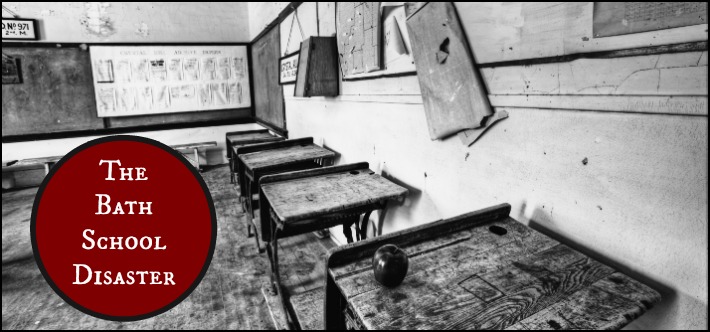Note: Portions of this post originally appeared in my blog, My Michigan, which details unique people, places, and events in the Great Lakes State.
——————–
America’s worst school-related mass murder took place on May 18, 1927 in the sleepy community of Bath, Michigan, located a few miles northeast of the state capital, Lansing.
The Bath School Disaster is a little-known event, having been pushed from national headlines a few days after it occurred by Charles Lindbergh’s historic transatlantic flight. However, it’s one of the nation’s most significant tragedies; 45 people (mostly children) lost their lives and another 58 were injured at the hands of a deranged local man, Andrew Kehoe, who bombed the school over slights he believed he had suffered at the hands of fellow community members.
Kehoe had purchased a farm in Bath in 1919 and quickly became a thorn in the sides of local leaders. He was an intelligent man, but impatient and frugal. One source of his ire was the Bath Consolidated School , which the community had built so that all the district’s students could attend a single school, rather than divide themselves among the one-room schoolhouses that dotted the area. Kehoe railed against the higher taxes the consolidated school required, but construction proceeded regardless, and the school opened in 1922.
Kehoe eventually served as treasurer of the consolidated school board, where his combative personality and penny-pinching ways made him a difficult person with whom to work. During this time, Kehoe suffered a series of financial and emotional setbacks; his wife was sick with tuberculosis, he couldn’t pay his bills, and, in 1926, his mortgage company announced the start of foreclosure proceedings on his farm. Many students of the disaster believe that Kehoe’s “last straw” was the fact that he lost a race for town clerk in 1926; it was after this supposed slight that he developed his plans to bomb the school.
Kehoe began stockpiling explosives, which he planted in the school’s basement under the guise that he was working on its lighting system. On May 18, 1927, a few days shy of graduation, Kehoe set his plan in motion. Sometime in the days before the bombing, he had killed his wife, Nellie. Around 8:45 a.m. on the 18th, Kehoe set off firebombs he had wired throughout his farm. (Nellie’s body would later be found there, in the charred remains of a chicken coop.) At almost the same time, an alarm clock set by Kehoe detonated the explosives he had planted under the school. The school’s north wing collapsed into a heap of rubble, taking its young occupants and their teachers with it.
Kehoe’s deadly work wasn’t done. As volunteers rushed between his farm and the school, trying to save whoever they could, Kehoe drove his truck, loaded with explosives and metal shrapnel, into town, and parked it near the school. He called to Superintendent Emory Huyck, with whom Kehoe had a fractious relationship. Huyck approached the truck. A witness later testified that he saw Kehoe and Huyck grapple over a gun that Kehoe had brought with him. Suddenly, the truck exploded, killing both Kehoe and Huyck, as well as three other people (including an eight-year-old boy). The blast injured several others.
By the time Kehoe was done wreaking his vengeance, 45 people (including Kehoe and his wife) had died, and 58 had been injured. More would surely have died but for the fact that the explosives Kehoe had wired under the school’s south wing did not detonate, possibly because of a short circuit caused by the first explosion.
While Bath struggled to recover, donations poured in from across the nation, including $75,000 from James J. Couzens, Michigan’s U.S. Senator. In 1928, the new James Couzens Agricultural School opened on the site of the consolidated school building, and served students until its demolition in 1975. The site now contains a memorial park, the centerpiece of which is a cupola that survived the school bombing. The cupola pays tribute to those who lost their lives in one of the deadliest tragedies in Michigan’s—and the nation’s—history.

Leave a Reply